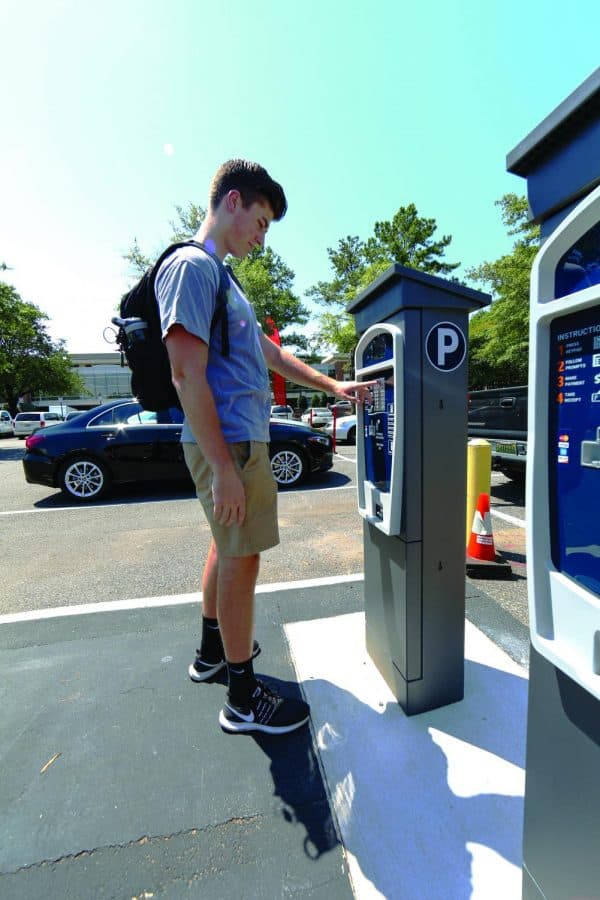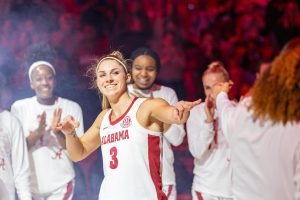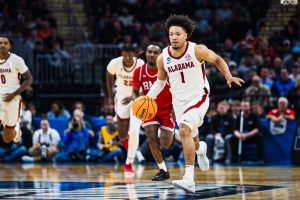Kiosks raise questions about parking access for all
August 19, 2019
It usually takes less than 30 minutes to sign off on a package from the mail center or to pick up takeout from a Bama Dining venue. But, until now, a brief errand could mean a lengthy commute, a credit card charge or a costly citation.
Starting August 19, anyone with a chargeable card can park in the 73 new spots in the south end of the Ferguson Lot for free – for up to 30 minutes. After that, it will cost $1 to park the first hour and $2 for each consecutive hour in the lot.
“We write several hundred citations in the Ferguson Lot monthly,” said Chris D’Esposito, director of transportation services. “The goal is to provide a little more space for students to have a quick in and out and provide more parking for faculty and staff by reducing the illegal parking going on.”
But while officials at transportation services consider the kiosks, which have also been placed around the recreation center and on Campus Drive, to be parking “enhancements,” some worry about what the changes may mean for faculty and staff commuters.
DOING THE MATH
The spots that are now open to anyone willing to pay per hour used to be reserved for faculty and staff. This means that the total number of green tag spaces in the lot will be reduced from 435 to 366.
While one parking and transportation officer will be assigned to the lot, Rona Donahoe, the president of the UA Faculty Senate, said she suspected students would continue to illegally park outside of the allotted pay-to-park area. In an email to faculty and staff, Donahoe shared her concerns. The email featured a thread between Donahoe, Provost Kevin Whitaker, D’Esposito and vice president for financial affairs Matt Fajack. Donahoe first reached out to Whitaker on July 31 about changes she noticed in the lot.
“During the academic year, the lot is completely full by 9:00 AM,” she said in the email to Whitaker. “Anyone who leaves the lot after 9:00 AM is typically unable to find a parking spot when they return because of students illegally parking in designated green spaces.”
Donahoe noted in the email that she had seen no news of plans for the changes underway in University publications, except for an announcement in UA News on June 24. Donahoe said she was worried the reduced spaces could prove disaster for faculty and staff commuters.
“These unannounced changes will significantly reduce the number of available green tag spaces in the North Ferguson Lot,” she said in the first email to Whitaker. “The outrage that this will generate among the faculty and staff who use this lot will be volcanic.”
Whitaker forwarded the message to D’Esposito and Fajack, expressing that he understood the concern.
D’Esposito responded that the changes were discussed in a meeting with Fajack in late March, and that it was presented to and approved by the Parking and Transportation Committee in late April. He said five publicized Town Hall meetings were held on June 26 and 27 in Rose Administration, Lloyd Hall, Graves Hall, and at the Ferguson Center as well as an additional personalized meeting in HM Comer in July.
“Illegal parking by far drives the capacity issue that faculty staff experience, we also accommodate several academic meetings in the lot annually, Board of Visitors for Engineering, Spanish Day, E-Day, and so on,” D’Esposito wrote. “To address these capacity issues, we wanted to find a way to encourage legal parking. We have seen a tremendous response to the existing pay stations located at the Upper Recreation Center Surface Lot as well as the Campus Drive Surface Lot. We have found that providing individuals with an economically friendly approach … and in a convenient location encourages the individual to do the correct thing.”
D’Esposito also said in the email response that a recent change in campus tours would redirect prospective students and families to the Ferguson Lot instead of Bryant Denny Stadium, and that a scannable voucher code system used with the kiosk would be a more efficient way of ensuring their stay was free of charge.
Matthew Hudnall, the Faculty Senate’s representative to the Parking and Transportation Committee told the Crimson White that plans were introduced to the committee on April 24. The minutes from that meeting show discussions of earlier plans to install a kiosk at the Campus Drive deck, which preceded a proposal on the changes to the Ferguson Lot. Hudnall said he thought most of the confusion from faculty was likely about when the changes to the Ferguson Lot would occur.
“Irrespective of the order of which things happened, I still think it’s a positive thing, or it’s at least worth trying,” he said, citing the amount of tickets given to students in the lot.
D’Esposito noted in the email that the North Ferguson Lot, which previously had only five visitors spots, is one of the most highly ticketed parking areas on campus, generating around 500 to 600 citations a month. D’Esposito said citation revenue varies year to year but will average between $1.6 and $2 million annually. From August of last year to July of this year, the two pay stations were used over 33,400 times and reaped just over $85,000. Permits, however, generate the most revenue for the department, at about $8 million per year.
Because the department is not funded by the University, that money goes back into campus infrastructure, such as roadways, parking decks and signage.
THE BOTTOM LINE
The installation of these pay-to-park spaces follow several efforts by the Faculty Senate to make parking more affordable, including decreasing permit prices for adjunct faculty and graduate students. Meeting minutes from September 2018 show that about half of all students purchased permits last year, whereas 85% of faculty and staff purchased permits. Currently, transportation services is working off of a $3 million debt-service to purchase buses, pave roadways and lots, pay salaries and support ten parking decks.
Hudnall said he considers the pay-to-park efforts to be an experiment in providing more services to a growing population of students while facing challenges that come with being self-funded.
“I personally think Transportation Services is doing all that they can to work within their constrained budget and are looking for innovative ways to reduce costs to faculty, staff, and students,” Hudnall said in an email. “… UA has undergone unprecedented growth over the past decade and while many buildings and infrastructure have been funded centrally, much of transportation was not due to the way it was structured.”
This year, parking tag fees have stalled for the first time in several years, even after efforts to introduce evening permits failed amid pushback. But student responses to the most recent plans varied. Some felt that pay stations were ideal for visitors and provided an alternative to parking in zones far from class, whereas others remained critical of the fees expected of them.
Elissa Robinson is a senior majoring in secondary education who works at the Ferguson Center. She said she was there when the initial plans were proposed to her staff. Workers at the Ferguson Center are typically encouraged to buy the green faculty/staff passes, which are $345 – almost enough to cover Robinson’s monthly rent.
“They were like, ‘Oh, here’s a new option for you if you work at the Ferg,’” Robinson said. “But I mean if you’re working 8 hour shifts, then… Like, I see where they’re trying to go. Once you calculate how much you pay by the hour, you’re like, ‘Oh, well I might as well just buy a parking pass.’”
Rachelle Cook, a recent graduate in kinesiology, said she understands concerns among some faculty and staff about the loss of parking spots.
“I think it’s just, no one is going to be happy no matter what because parking is terrible,” she said.
Cook, who broke her kneecap after slipping in ten Hoor last year, was wearing a brace when she was asked to run an errand at the Ferguson Center for her on-campus internship.
“Taking the bus was awful,” she said. “People glared at me because my leg would take up the whole aisleway.”
So Cook drove, and when she couldn’t find a spot in the temporary spots closer to the building, she parked illegally – and came back to find a ticket. Cook said she has taken advantage of other pay-to-park areas due to her sustained injury, which cost her about $8 per day. For her, the changes in the Ferguson Lot provide similar opportunities, as well as concerns.
“It’s definitely nice because before, you couldn’t park there at all and now at least if you need to go pick up a package, you can do that and you’re not going to come back to a $50 ticket,” she said. “The only thing that I wouldn’t like about that is I feel like a lot of people are going to park there for class, and then we’re all back to square one.”
As the department ventures toward a new strategic plan, Hudnall urged others to hang tight.
“Those costs, like parking deck capital investments, have to be funded by hang tag prices and other innovative revenue sources like parking meters,” Hudnall said. “The impact of electric and autonomous vehicles, ride sharing, and many other aspects are being considered to minimize costs and have UA be prepared for the changes that the rest of the world is facing as well.”
Rona Donahoe, the Faculty Senate president, could not be reached for comment by the time of publication.





















